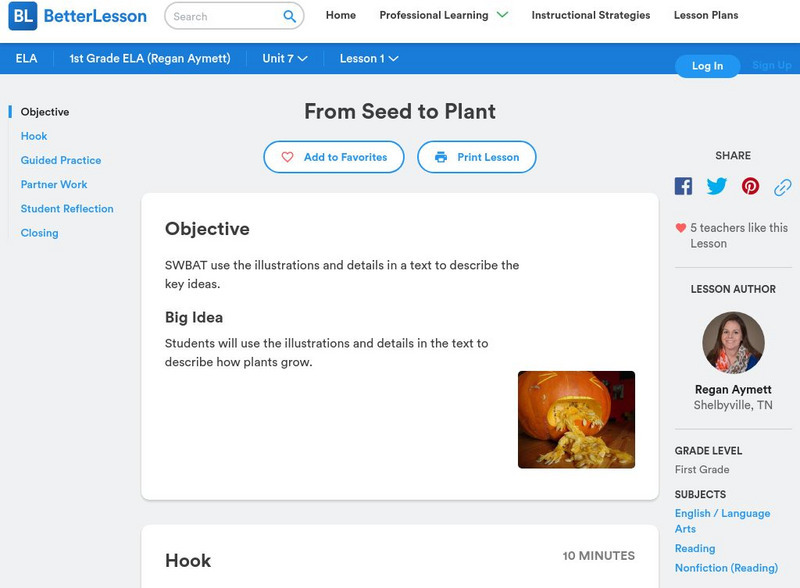Curated OER
What are rice farmers doing to help the environment with their water-filled rice fields?
Third graders research rice fields. In this rice fields lesson, 3rd graders discuss how fields contribute to the environment by providing an important food source for birds. They find the benefits of rice fields to water and soil as...
Curated OER
Cultivating Oklahoma's Future
In this Oklahoma agriculture lesson plan, 8th graders read and discuss information and vocabulary about new developments in agriculture. Students write essays on the future of agriculture in Oklahoma.
Curated OER
Discovering Growth Patterns
In this statistics worksheet, students examine data on a variety of subjects related to growth patterns and apply the data to 4 different graphs.
Curated OER
Eat A Rainbow!
Students demonstrate the importance of eating fruits and vegetables. In this nutrition instructional activity, students identify and sort different fruits and vegetables by colors. Students list reasons why eating fruits and vegetables...
Curated OER
Winter Survival
Students examine what animals need in order to survive. For this investigative lesson students play a "role" of an animal in winter.
Curated OER
Birth, Growth, And Development
Pupils understand that all living things have a life cycle that includes being born, developing into an adult, reproducing, and eventually dying.
Curated OER
WEEDS ON THE WINDOWSILL
Discuss the suffix "cide." Have students name words having this suffix (homicide, suicide, genocide). Ask students what all these words have in common. Then ask students to define the word "pesticide." (Pesticides control organisms that...
Curated OER
A DAY WITHOUT AG
Students consider and discuss the meaning of the word "agriculture" and how agriculture affects their lives every day. Students identify the various ways that agriculture touches their personal lives. Students use worksheets to list all...
Curated OER
Floristic Relay
Fifth graders identify the role succession plays in the adaptation of our environment. Students identify pioneer and climax species and order habitats in succession. They recognize that different characteristics of species make them...
Curated OER
Garden Journals
Students create "Garden Journals" using construction paper, poster board, and general art supplies in this Art, Science, Reading, and Writing lesson for the early-elementary classroom. This activity may be done at the beginning of the...
Curated OER
Little Bloomers: Gardening With Trees
Students identify the parts of tree flowers. They examine the role they have in pollination. They discuss trees that do not flower as well.
Curated OER
Field Of Beans
Pupils investigate the concept of crop farming. They plant small fields to test different theories of agriculture. Students keep care over the fields, including pest and weed control. Pupils make and record daily observations to measure...
Curated OER
Vegetable Twister
Students review vegetables and their nutrient values and production. In this vegetable production worksheet, students read information about the nutrients in vegetables and how they are grown. Students participate in a game of Twister to...
Curated OER
The Grass is Always Greener
Third graders experiment with common grass and cellular division.
Curated OER
JUST A MATTER OF TIME
Students recognize the dynamic changes in themselves and in agriculture that have occurred through the years. They are shown pictures of a baby or students are asked to think of their little brothers or sisters or themselves in...
Curated OER
Let's Think About... Change
Students observe various examples of "change." They mix paint to cereate new colors, eat bread and then toasted bread, and match baby pictures with pictures of how the same people look in the present. Finally, they watch a bouquet of...
Curated OER
Frame Animation
Students examine the idea that an object might never have a "fixed" existence and may be a thing existing always in flux by creating a frame-based animation of something that transforms from one shape into another. They create...
Curated OER
Winer Survival
Students study how animals need water, food, shelter, and space to survive. They also study what animals need to survive in the winter. They play the part of animals and winter "threats" in a game of tag to reinforce concepts.
Science & Plants for Schools
Science & Plants for Schools: Teaching Resources
A collection of teaching resources to help students explore plants! Resources investigate anatomy of plants, reproduction and life cycles, fruits, seeds, classification, photosynthesis, factors that affect plant growth, and respiration....
University of Florida
Florida Museum of Natural History: Plant Life
This teacher's guide focuses on the fascinating world of plants. Through books and other print materials, and exploration of actual plants, children will identify plants as living things, examine the parts of plants, experiment with what...
Science Education Resource Center at Carleton College
Serc: Mn Step: Seeds to Plants: How to Grow a Plant
An experiment where first-graders plant seeds and monitor their growth. Prior to planting, they decide on an inquiry question, and how they will find out the answer through the experiment.
Better Lesson
Better Lesson: From Seed to Plant
Students will use the illustrations and details in the text to describe how plants grow. This lesson uses a complex text to allow students to analyze the pictures in From Seed to Plant and From Seed to Pumpkin. Included are videos and...
HotChalk
Hot Chalk: Lesson Plans Page: Planting Seeds
This simple lesson plan is designed to help young students be aware of how seeds sprout, and that seeds grow into plants.
HotChalk
Hot Chalk: Lesson Plans Page: Kick Off Seed Explorations
This simple lesson plan is designed to have young students become more familiar with fruit seeds by identifying fruit that contains seeds/no seeds, gathering seeds from fruit, explaining the importance of seeds, explaining that seeds...























